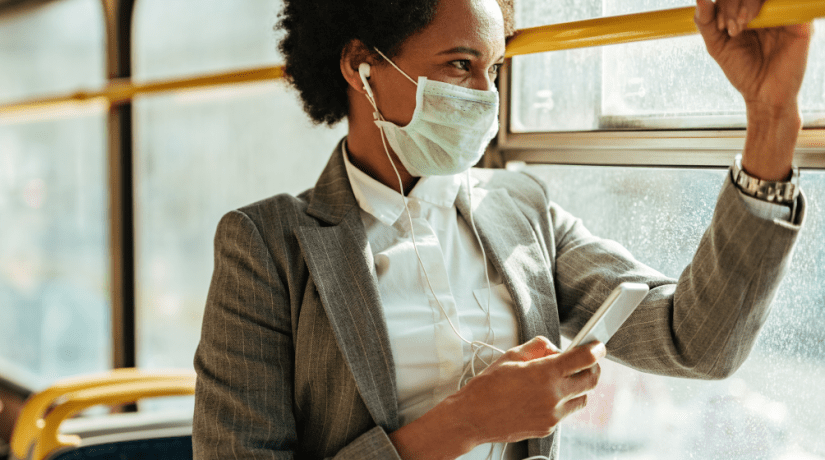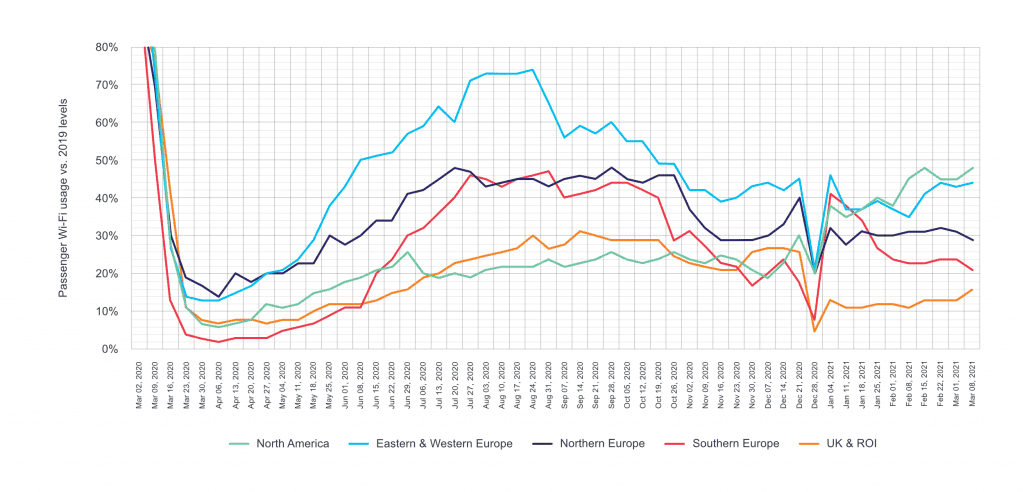A new report from Icomera tracks public transport’s progress through the pandemic, and details the connectivity solutions and strategies for the industry’s recovery.
“Pandemic Year” Tracked by Passenger Wi-Fi
The report illustrates the impact of the pandemic on public transport in Europe and North America over the last 12 months through Passenger Wi-Fi usage levels – a reliable tracker of ridership trends. Data from 30,000+ trains, trams, buses, and coaches equipped with Icomera technology captures the dramatic decline through March 2020, the early signs of recovery stalling over the summer, and the very different winter holiday period that many experienced. Today, the regions that appear to have found an optimal balance between vaccination rollouts and the easing of restrictions are generally seeing the strongest recoveries. North America leads the way at 48% of 2019 levels – improving at an average rate of two percentage points per week since mid-January.
But ridership is just one metric, and Icomera also highlights instances where public transport has continued to demonstrate its societal, economic, and environmental value, adapting as quickly as any other industry, and continuing to safely operate services for those who needed it most.
An Internet-Enabled Recovery Plan
Many operators have taken advantage of the prolonged downtime to accelerate technology upgrade programmes and innovation pilots, propelled by real-time or on-demand access to data. Icomera calls this the industry’s “Internet-enabled recovery plan”:
- Restoring Passenger Confidence from Door to Destination
Prior to the journey, passengers will expect real-time updates on service timetables and vehicle occupancy levels, giving them “journey certainty”. Once on board, they will seek reassurances regarding their personal safety and health measures enacted by the operator. Digital information channels will reinforce the onboard safety measures in place.
- Making the Journey Count
Wi-Fi on trains and buses will support the flexible working hours and locations of the “work from home” transition, while onboard entertainment will offer immersive experiences, reducing the perceived journey time. If a journey can contribute to a productive day, and not disrupt it, then public transport will be the obvious and most effective modal choice for passengers.
- Achieving More with Less
Facing the challenge of operating with greater efficiency while meeting higher health, safety and security standards, operators are trialling new systems including vehicle performance sensors, thermal imaging and face mask detection cameras. Fast, appropriate responses to the data these systems generate will be essential to a cost-effective “predict and prevent” maintenance strategy, while also protecting passengers.
Mobile Internet Connectivity
With an increasing number of onboard devices requiring Internet connectivity, the increasing value of the data they generate, and the increasing importance of its timely availability, operators need mobile Internet connectivity solutions that efficiently utilise the coverage and capacity of existing cellular (and other) communication networks.
“This is the challenge that Icomera has been addressing for over 20 years, ensuring the wireless delivery of over 130 terabytes of data every day across our installed base,” says Magnus Friberg, CEO of Icomera.
“Whether we measure the recovery in terms of ridership numbers of leisure travellers, or in terms of access for the transit-dependent commuter, it will be driven by real-time and on-demand information for all, utilising a mix of new and existing technologies – Restoring confidence from door to destination, making every ride time-efficient for the passenger, and cost-effective for the operator.”
Download the full report: Public Transport’s Journey Through the Pandemic


